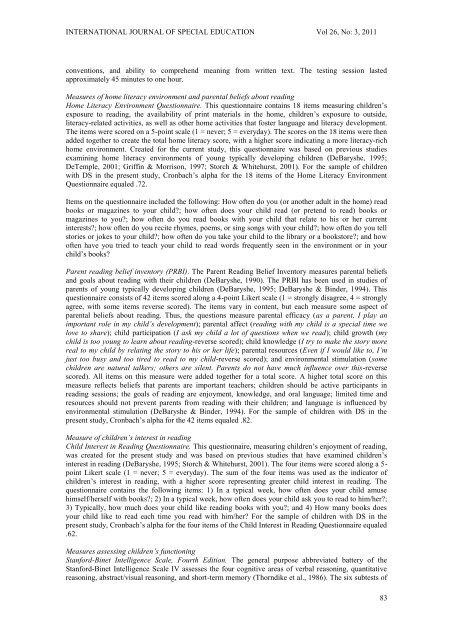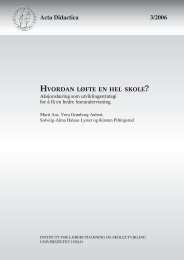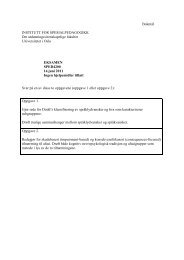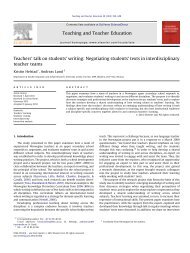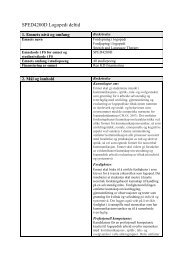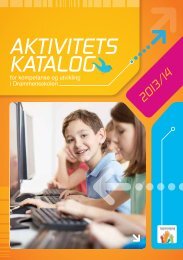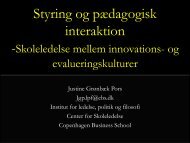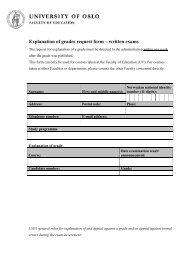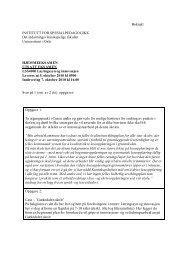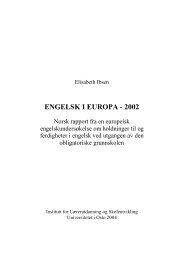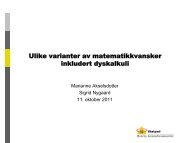International Journal Special Education
International Journal Special Education
International Journal Special Education
You also want an ePaper? Increase the reach of your titles
YUMPU automatically turns print PDFs into web optimized ePapers that Google loves.
INTERNATIONAL JOURNAL OF SPECIAL EDUCATION Vol 26, No: 3, 2011conventions, and ability to comprehend meaning from written text. The testing session lastedapproximately 45 minutes to one hour.Measures of home literacy environment and parental beliefs about readingHome Literacy Environment Questionnaire. This questionnaire contains 18 items measuring children’sexposure to reading, the availability of print materials in the home, children’s exposure to outside,literacy-related activities, as well as other home activities that foster language and literacy development.The items were scored on a 5-point scale (1 = never; 5 = everyday). The scores on the 18 items were thenadded together to create the total home literacy score, with a higher score indicating a more literacy-richhome environment. Created for the current study, this questionnaire was based on previous studiesexamining home literacy environments of young typically developing children (DeBaryshe, 1995;DeTemple, 2001; Griffin & Morrison, 1997; Storch & Whitehurst, 2001). For the sample of childrenwith DS in the present study, Cronbach’s alpha for the 18 items of the Home Literacy EnvironmentQuestionnaire equaled .72.Items on the questionnaire included the following: How often do you (or another adult in the home) readbooks or magazines to your child?; how often does your child read (or pretend to read) books ormagazines to you?; how often do you read books with your child that relate to his or her currentinterests?; how often do you recite rhymes, poems, or sing songs with your child?; how often do you tellstories or jokes to your child?; how often do you take your child to the library or a bookstore?; and howoften have you tried to teach your child to read words frequently seen in the environment or in yourchild’s books?Parent reading belief inventory (PRBI). The Parent Reading Belief Inventory measures parental beliefsand goals about reading with their children (DeBaryshe, 1990). The PRBI has been used in studies ofparents of young typically developing children (DeBaryshe, 1995; DeBaryshe & Binder, 1994). Thisquestionnaire consists of 42 items scored along a 4-point Likert scale (1 = strongly disagree, 4 = stronglyagree, with some items reverse scored). The items vary in content, but each measure some aspect ofparental beliefs about reading. Thus, the questions measure parental efficacy (as a parent, I play animportant role in my child’s development); parental affect (reading with my child is a special time welove to share); child participation (I ask my child a lot of questions when we read); child growth (mychild is too young to learn about reading-reverse scored); child knowledge (I try to make the story morereal to my child by relating the story to his or her life); parental resources (Even if I would like to, I’mjust too busy and too tired to read to my child-reverse scored); and environmental stimulation (somechildren are natural talkers; others are silent. Parents do not have much influence over this-reversescored). All items on this measure were added together for a total score. A higher total score on thismeasure reflects beliefs that parents are important teachers; children should be active participants inreading sessions; the goals of reading are enjoyment, knowledge, and oral language; limited time andresources should not prevent parents from reading with their children; and language is influenced byenvironmental stimulation (DeBaryshe & Binder, 1994). For the sample of children with DS in thepresent study, Cronbach’s alpha for the 42 items equaled .82.Measure of children’s interest in readingChild Interest in Reading Questionnaire. This questionnaire, measuring children’s enjoyment of reading,was created for the present study and was based on previous studies that have examined children’sinterest in reading (DeBaryshe, 1995; Storch & Whitehurst, 2001). The four items were scored along a 5-point Likert scale (1 = never; 5 = everyday). The sum of the four items was used as the indicator ofchildren’s interest in reading, with a higher score representing greater child interest in reading. Thequestionnaire contains the following items: 1) In a typical week, how often does your child amusehimself/herself with books?; 2) In a typical week, how often does your child ask you to read to him/her?;3) Typically, how much does your child like reading books with you?; and 4) How many books doesyour child like to read each time you read with him/her? For the sample of children with DS in thepresent study, Cronbach’s alpha for the four items of the Child Interest in Reading Questionnaire equaled.62.Measures assessing children’s functioningStanford-Binet Intelligence Scale, Fourth Edition. The general purpose abbreviated battery of theStanford-Binet Intelligence Scale IV assesses the four cognitive areas of verbal reasoning, quantitativereasoning, abstract/visual reasoning, and short-term memory (Thorndike et al., 1986). The six subtests of83


